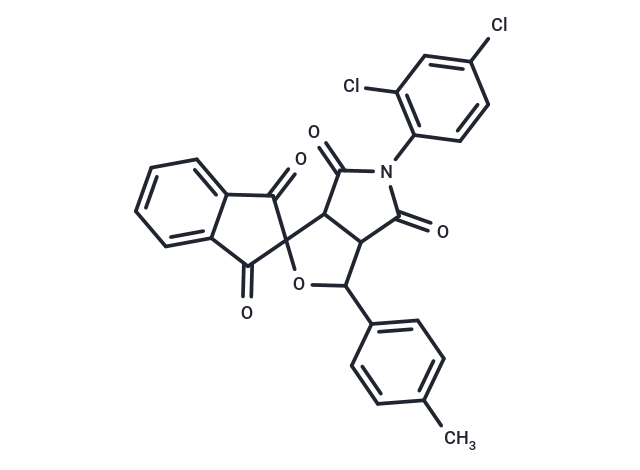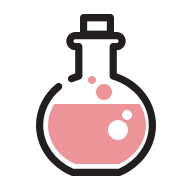- Remove All
 Your shopping cart is currently empty
Your shopping cart is currently empty
Shopping Cart
ML-T7
Catalog No. T86911Cas No. 459789-75-4
ML-T7, a powerful inhibitor of Tim-3, effectively disrupts its interactions with PtdSer and CEACAM1. This compound enhances the antitumor activity of adoptive transfer therapy involving cytotoxic T lymphocytes (CTLs) and CAR T cells, while also boosting T cell effector functions. Additionally, ML-T7 augments the killing activity of NK cells against tumor cells and improves the antigen-presenting capacity of dendritic cells (DCs). Demonstrating antitumor efficacy in preclinical models, ML-T7 shows potential either as a standalone treatment or in combination with Nivolumab for tumor immunotherapy research [1].

ML-T7
Catalog No. T86911Cas No. 459789-75-4
ML-T7, a powerful inhibitor of Tim-3, effectively disrupts its interactions with PtdSer and CEACAM1. This compound enhances the antitumor activity of adoptive transfer therapy involving cytotoxic T lymphocytes (CTLs) and CAR T cells, while also boosting T cell effector functions. Additionally, ML-T7 augments the killing activity of NK cells against tumor cells and improves the antigen-presenting capacity of dendritic cells (DCs). Demonstrating antitumor efficacy in preclinical models, ML-T7 shows potential either as a standalone treatment or in combination with Nivolumab for tumor immunotherapy research [1].
| Pack Size | Price | Availability | Quantity |
|---|---|---|---|
| 10 mg | Inquiry | 10-14 weeks | |
| 50 mg | Inquiry | 10-14 weeks |
Bulk & Custom
Add to Cart
Questions
View MoreContact us for more batch information
Resource Download
Product Introduction
Bioactivity
Chemical Properties
| Description | ML-T7, a powerful inhibitor of Tim-3, effectively disrupts its interactions with PtdSer and CEACAM1. This compound enhances the antitumor activity of adoptive transfer therapy involving cytotoxic T lymphocytes (CTLs) and CAR T cells, while also boosting T cell effector functions. Additionally, ML-T7 augments the killing activity of NK cells against tumor cells and improves the antigen-presenting capacity of dendritic cells (DCs). Demonstrating antitumor efficacy in preclinical models, ML-T7 shows potential either as a standalone treatment or in combination with Nivolumab for tumor immunotherapy research [1]. |
| In vitro | ML-T7 (10 μM, 0-6 days) enhances the TCR/STAT5 signaling pathway via Tim-3, thereby promoting the anti-tumor activity of CD8+ cells [1]. When applied at 10 μM for 24 hours, ML-T7 facilitates the maturation and function of dendritic cells (DCs) through Tim-3 and Tim-4, boosting their antigen-presenting capabilities [1]. Additionally, ML-T7 (10 μM, 24 h) enhances cytotoxic T lymphocyte (CTL) activation and cytokine production, while reducing CTL apoptosis [1]. At a concentration of 10 μM for 48 hours, ML-T7 significantly increases the production of IFN-γ, TNF-α, CD107a, and granzyme B in the human NK cell line NK92 [1]. Western blot analysis in CD8+ cells at 10 μM for 0-6 days showed increased phosphorylation of phospholipase C–γ1 (PLC-γ1), ZAP70, LCK, ERK1/2, and STAT5 in response to anti-CD3/CD28 stimulation. In a cell invasion assay using bone marrow cells and a 10 μM concentration for 24 hours, ML-T7 elevated the expression of DC maturation markers. |
| In vivo | ML-T7, administered intraperitoneally at 10-50 mg/kg every two days for 10 doses, has been shown to inhibit tumor growth and extend the survival of mice without adverse effects on mouse body weight. At a dose of 20 mg/kg, in combination with Nivolumab, ML-T7 enhances the antitumor activity of Nivolumab and significantly improves the survival rate in HCC mice. Additionally, ML-T7 at 50 mg/kg every two days for three weeks demonstrates good safety in mice. In 10-week-old mice with spontaneous orthotopic HCC, treatment leads to increased CD8+ T cells in tumors and spleen, reduction of T cell exhaustion, and improved function of CTLs, NK cells, and DCs. Furthermore, in 10-week-old mice with orthotopic Akt/c-Myc HCC, ML-T7 at 20 mg/kg exhibits enhanced antitumor activity alongside Nivolumab, rejuvenates NK cells, and inhibits the accumulation of MDSCs and Tregs. |
| Molecular Weight | 506.33 |
| Formula | C27H17Cl2NO5 |
| Cas No. | 459789-75-4 |
Storage & Solubility Information
| Storage | Powder: -20°C for 3 years | In solvent: -80°C for 1 year | Shipping with blue ice. |
Calculator
In Vivo Formulation Calculator (Clear solution)
Please enter your animal experiment information in the following box and click Calculate to obtain the mother liquor preparation method and in vivo formula preparation method:
Mother liquor preparation method: 2 mg of drug dissolved in 50 μL DMSO (mother liquor concentration of 40 mg/mL), if you need to configure a concentration that exceeds the solubility of the product, please contact us first.
(mother liquor concentration of 40 mg/mL), if you need to configure a concentration that exceeds the solubility of the product, please contact us first.
Preparation method for in vivo formula: Take 50 μL DMSO main solution, add 300 μLPEG300
main solution, add 300 μLPEG300 mix well and clarify, then add 50 more μL Tween 80, mix well and clarify, then add 600 more μLddH2O
mix well and clarify, then add 50 more μL Tween 80, mix well and clarify, then add 600 more μLddH2O mix well and clarify
mix well and clarify
For Reference Only. Please develop an appropriate dissolution method based on your laboratory animals and route of administration.
Dose Conversion
You can also refer to dose conversion for different animals. More Dose Conversion
Tech Support
Please see Inhibitor Handling Instructions for more frequently ask questions. Topics include: how to prepare stock solutions, how to store products, and cautions on cell-based assays & animal experiments, etc
Related Tags: buy ML-T7 | purchase ML-T7 | ML-T7 cost | order ML-T7 | ML-T7 chemical structure | ML-T7 in vivo | ML-T7 in vitro | ML-T7 formula | ML-T7 molecular weight

Copyright © 2015-2025 TargetMol Chemicals Inc. All Rights Reserved.




